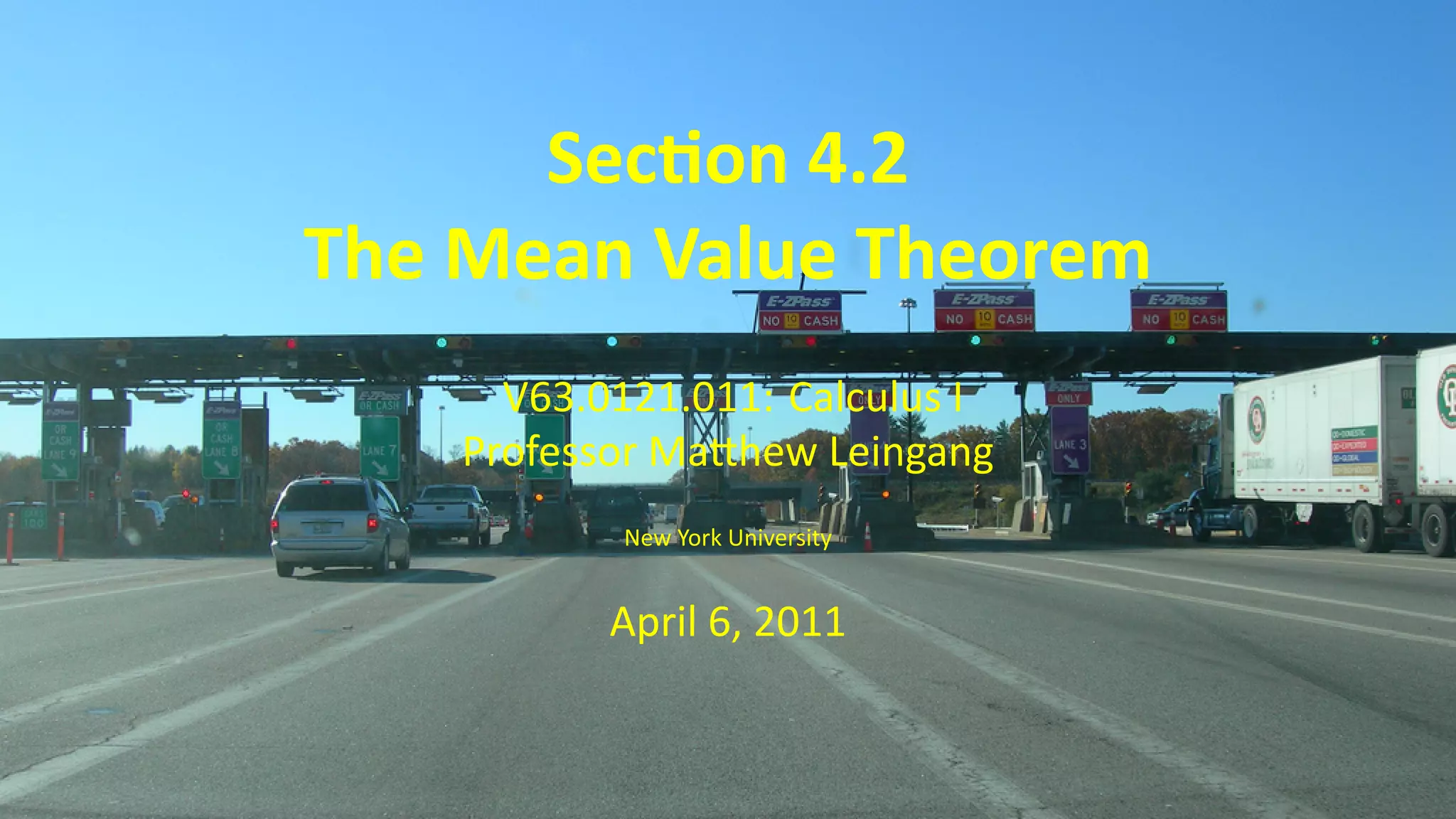The document discusses the Mean Value Theorem (MVT) and Rolle's Theorem, providing their mathematical statements and proofs, as well as applications and examples. It outlines the importance of these theorems in understanding functions that are continuous and differentiable on certain intervals. Additionally, it addresses specific examples demonstrating the uniqueness of solutions to equations and the implications of theorems in real-world scenarios.






![Mathematical Statement of Rolle’s
Theorem
Theorem (Rolle’s Theorem)
Let f be con nuous on [a, b]
and differen able on (a, b).
Suppose f(a) = f(b). Then
there exists a point c in
(a, b) such that f′ (c) = 0. .
a b](https://image.slidesharecdn.com/lesson19-themeanvaluetheorem011slides-110407075645-phpapp01/75/Lesson-19-The-Mean-Value-Theorem-slides-7-2048.jpg)
![Mathematical Statement of Rolle’s
Theorem
Theorem (Rolle’s Theorem)
c
Let f be con nuous on [a, b]
and differen able on (a, b).
Suppose f(a) = f(b). Then
there exists a point c in
(a, b) such that f′ (c) = 0. .
a b](https://image.slidesharecdn.com/lesson19-themeanvaluetheorem011slides-110407075645-phpapp01/75/Lesson-19-The-Mean-Value-Theorem-slides-8-2048.jpg)
![Flowchart proof of Rolle’s Theorem
endpoints
Let c be
. Let d be
. . .
are max
the max pt the min pt
and min
f is
is c.an is d. an. .
yes yes constant
endpoint? endpoint?
on [a, b]
no no
′ ′ f′ (x) .≡ 0
f (c) .= 0 f (d) .= 0
on (a, b)](https://image.slidesharecdn.com/lesson19-themeanvaluetheorem011slides-110407075645-phpapp01/75/Lesson-19-The-Mean-Value-Theorem-slides-9-2048.jpg)


![The Mean Value Theorem
Theorem (The Mean Value Theorem)
Let f be con nuous on
[a, b] and differen able on
(a, b). Then there exists a
point c in (a, b) such that
f(b) − f(a) b
= f′ (c). .
b−a a](https://image.slidesharecdn.com/lesson19-themeanvaluetheorem011slides-110407075645-phpapp01/75/Lesson-19-The-Mean-Value-Theorem-slides-12-2048.jpg)
![The Mean Value Theorem
Theorem (The Mean Value Theorem)
Let f be con nuous on
[a, b] and differen able on
(a, b). Then there exists a
point c in (a, b) such that
f(b) − f(a) b
= f′ (c). .
b−a a](https://image.slidesharecdn.com/lesson19-themeanvaluetheorem011slides-110407075645-phpapp01/75/Lesson-19-The-Mean-Value-Theorem-slides-13-2048.jpg)
![The Mean Value Theorem
Theorem (The Mean Value Theorem)
Let f be con nuous on c
[a, b] and differen able on
(a, b). Then there exists a
point c in (a, b) such that
f(b) − f(a) b
= f′ (c). .
b−a a](https://image.slidesharecdn.com/lesson19-themeanvaluetheorem011slides-110407075645-phpapp01/75/Lesson-19-The-Mean-Value-Theorem-slides-14-2048.jpg)




![Proof of the Mean Value Theorem
Proof.
The line connec ng (a, f(a)) and (b, f(b)) has equa on
f(b) − f(a)
L(x) = f(a) + (x − a)
b−a
Apply Rolle’s Theorem to the func on
f(b) − f(a)
g(x) = f(x) − L(x) = f(x) − f(a) − (x − a).
b−a
Then g is con nuous on [a, b] and differen able on (a, b) since f is.](https://image.slidesharecdn.com/lesson19-themeanvaluetheorem011slides-110407075645-phpapp01/75/Lesson-19-The-Mean-Value-Theorem-slides-19-2048.jpg)
![Proof of the Mean Value Theorem
Proof.
The line connec ng (a, f(a)) and (b, f(b)) has equa on
f(b) − f(a)
L(x) = f(a) + (x − a)
b−a
Apply Rolle’s Theorem to the func on
f(b) − f(a)
g(x) = f(x) − L(x) = f(x) − f(a) − (x − a).
b−a
Then g is con nuous on [a, b] and differen able on (a, b) since f is.
Also g(a) = 0 and g(b) = 0 (check both).](https://image.slidesharecdn.com/lesson19-themeanvaluetheorem011slides-110407075645-phpapp01/75/Lesson-19-The-Mean-Value-Theorem-slides-20-2048.jpg)

![Using the MVT to count solutions
Example
Show that there is a unique solu on to the equa on x3 − x = 100 in the
interval [4, 5].](https://image.slidesharecdn.com/lesson19-themeanvaluetheorem011slides-110407075645-phpapp01/75/Lesson-19-The-Mean-Value-Theorem-slides-22-2048.jpg)
![Using the MVT to count solutions
Example
Show that there is a unique solu on to the equa on x3 − x = 100 in the
interval [4, 5].
Solu on
By the Intermediate Value Theorem, the func on f(x) = x3 − x
must take the value 100 at some point on c in (4, 5).](https://image.slidesharecdn.com/lesson19-themeanvaluetheorem011slides-110407075645-phpapp01/75/Lesson-19-The-Mean-Value-Theorem-slides-23-2048.jpg)
![Using the MVT to count solutions
Example
Show that there is a unique solu on to the equa on x3 − x = 100 in the
interval [4, 5].
Solu on
By the Intermediate Value Theorem, the func on f(x) = x3 − x
must take the value 100 at some point on c in (4, 5).
If there were two points c1 and c2 with f(c1 ) = f(c2 ) = 100,
then somewhere between them would be a point c3 between
them with f′ (c3 ) = 0.](https://image.slidesharecdn.com/lesson19-themeanvaluetheorem011slides-110407075645-phpapp01/75/Lesson-19-The-Mean-Value-Theorem-slides-24-2048.jpg)
![Using the MVT to count solutions
Example
Show that there is a unique solu on to the equa on x3 − x = 100 in the
interval [4, 5].
Solu on
By the Intermediate Value Theorem, the func on f(x) = x3 − x
must take the value 100 at some point on c in (4, 5).
If there were two points c1 and c2 with f(c1 ) = f(c2 ) = 100,
then somewhere between them would be a point c3 between
them with f′ (c3 ) = 0.
However, f′ (x) = 3x2 − 1, which is posi ve all along (4, 5). So
this is impossible.](https://image.slidesharecdn.com/lesson19-themeanvaluetheorem011slides-110407075645-phpapp01/75/Lesson-19-The-Mean-Value-Theorem-slides-25-2048.jpg)

![Using the MVT to estimate
Example
We know that |sin x| ≤ 1 for all x, and that sin x ≈ x for small x.
Show that |sin x| ≤ |x| for all x.
Solu on
Apply the MVT to the func on
f(t) = sin t on [0, x]. We get Since |cos(c)| ≤ 1, we get
sin x − sin 0 sin x
= cos(c) ≤ 1 =⇒ |sin x| ≤ |x|
x−0 x
for some c in (0, x).](https://image.slidesharecdn.com/lesson19-themeanvaluetheorem011slides-110407075645-phpapp01/75/Lesson-19-The-Mean-Value-Theorem-slides-27-2048.jpg)
![Using the MVT to estimate II
Example
Let f be a differen able func on with f(1) = 3 and f′ (x) < 2 for all x
in [0, 5]. Could f(4) ≥ 9?](https://image.slidesharecdn.com/lesson19-themeanvaluetheorem011slides-110407075645-phpapp01/75/Lesson-19-The-Mean-Value-Theorem-slides-28-2048.jpg)











![Why the MVT is the MITC
(Most Important Theorem In Calculus!)
Theorem
Let f′ = 0 on an interval (a, b). Then f is constant on (a, b).
Proof.
Pick any points x and y in (a, b) with x < y. Then f is con nuous on
[x, y] and differen able on (x, y). By MVT there exists a point z in
(x, y) such that
f(y) − f(x)
= f′ (z) = 0.
y−x
So f(y) = f(x). Since this is true for all x and y in (a, b), then f is
constant.](https://image.slidesharecdn.com/lesson19-themeanvaluetheorem011slides-110407075645-phpapp01/75/Lesson-19-The-Mean-Value-Theorem-slides-40-2048.jpg)













![MVT to the rescue
Lemma
Suppose f is con nuous on [a, b] and lim+ f′ (x) = m. Then
x→a
f(x) − f(a)
lim+ = m.
x→a x−a](https://image.slidesharecdn.com/lesson19-themeanvaluetheorem011slides-110407075645-phpapp01/75/Lesson-19-The-Mean-Value-Theorem-slides-54-2048.jpg)



